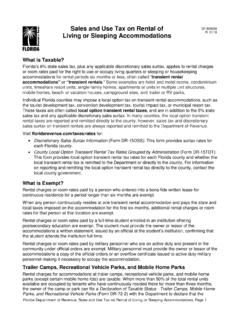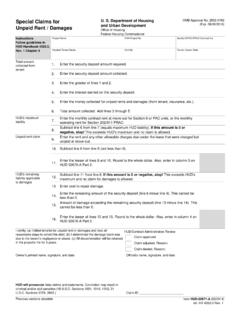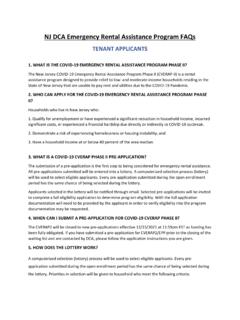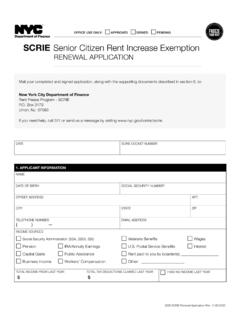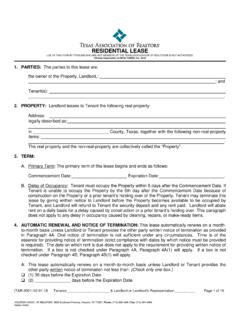Transcription of 4350.1 REV-1 CHAPTER 7. PROCESSING BUDGETED RENT …
1 REV-1 . _____. CHAPTER 7. PROCESSING BUDGETED RENT INCREASES. AND FEES FOR COMMERCIAL SPACE AND SERVICES IN. INSURED, DIRECT LOAN AND NON-REGULATED HUD PROJECTS. SECTION 1. OVERVIEW. 7-1. PURPOSE. This CHAPTER provides procedures for PROCESSING BUDGETED rent increases in certain HUD. projects and outlines guidance in the calculation of utility allowances and charges for commercial facilities and services provided in those projects. Included in the CHAPTER are the relevant tenant participation procedures which must be followed in PROCESSING these increases and charges . In preparing the procedures in this CHAPTER , HUD's prime interest is in promoting the efficient management and continued financial viability of its projects.
2 In reviewing requests from owners concerning rents and charges , the Field Office should be guided by the fact that these rents and fees should and must provide sufficient and adequate funding to operate the projects. This CHAPTER gives guidance on program evaluation used in conjunction with required procedures for MIPS BUDGETED rent increases. 7-2. APPLICABILITY. These procedures for PROCESSING a gross potential rent increase, increases in charges for commercial space and charges for services apply to the projects listed below: A. Section 231, and 221(d)(3) market rate projects: 231 projects (LDs) whose rents are still controlled or who have opted for the alternate rent mechanism. B. Section 202 projects, except those that use the Section 8 Annual Adjustment Factor (AAF).
3 C. Section 213, Section 236 (including cooperatives), Rent Supplement, 221(d)(3) market rate and 221(d)(3) BMIR rental and cooperative projects, Sections 810 and 908 (military housing);. D. Projects that have converted from Rent Supplement to Section 8 Loan Management Set-Aside;. _____. 7-1 9/92. _____. REV-1 . _____. E. Previously HUD-owned projects that have been sold to nonprofit owners or that use a budget (rather than the Section 8 AAF) to compute rents;. F. Section 207's and 231's both regulated and controlled by alternative rent mechanism; Section 220 and 221(d)(4)'s that are regulated; and 234. rentals that did not convert to condominiums;. G. Those projects listed in paragraph 7-2(A) through (F) that are not automatically preempted by HUD.
4 And request exemption from local rent control. NOTE: Regulatory agreements require Section 202, Section 231 and cooperative projects to annually submit operating budgets and obtain HUD approval of rents or carrying charges . Field Offices shall enforce this requirement in lieu of the requirement that budgets be submitted only when the owner believes a rent increase is needed. The Field Office in enforcing the regulatory agreement requirement for annual budget submissions, shall require the owner to include in their submission any information required by Section 4, paragraph 7-22 of these procedures. 7-3. PROJECTS SUBJECT TO THE ALTERNATE RENT DETERMINATION. MECHANISM. For projects insured under Section 207, 231(c)(4), 213.
5 Rental, 223(f), and 234 Rental prior to November 30, 1983, and for 221(d)(4) projects, regardless of when the project was insured, the owners may request an amendment to the Regulatory Agreement subject to Section 3 of this CHAPTER requiring HUD to determine their rents using the alternative rent mechanism described in Section 4. 7-4. DEFINITIONS. A. HUD Authorized Rent. These are the unit rents shown in column 3 of the most recently approved Rent Schedule (Form HUD-92458). In the Section 236. program these rents are called basic rents. Depending on income, some 236 tenants will pay _____. 9/92 7-2. _____. REV-1 . _____. market rent or something between basic and market rents which represents 30 percent of adjusted income.
6 B. Maximum Allowable Rent Potential. The maximum annual rent the owner may collect by charging the rents authorized by HUD on the Form 92458. C. Utility Allowance. (APPLIES ONLY FOR PROJECTS. RECEIVING SUBSIDY ASSISTANCE WHERE ALL OR SOME. UTILITIES ARE PAID DIRECTLY BY THE TENANT.) An estimate of utility costs (except telephone) for an average family occupying a unit. Clarification: Section 221(d)(3) BMIR projects that were built with tenant paid utilities (separate meters) do not need utility allowances. If the project has Rent Supplement or LMSA units, those units however, receive an allowance. D. Section 8 Contract Rents. The rent level called for under the subsidy contract and adjusted annually.
7 Rent used for units subsidized under Section 8 (LMSA) where the owner has had his rent decontrolled or used the alternative rent mechanism. E. Services. This refers to such benefits as may be provided by the project owner to tenants that are not included in the rent and are optional on the tenant's part ( , cable , laundry facilities and use of community space in the project.). SECTION 2. TENANT COMMENT PROCEDURES FOR A RENT INCREASE. 7-5. GENERAL. Tenant comment procedures for the rent increase process are provided for in Section 202(b)(1). of the 1987 Housing and Community Development Amendments (HCDA) and Section 329(F) of the 1981 HCDA. Regulations at 24 CFR 245 set the Department's policy on the subject (See Appendix 1).
8 These requirements for tenant comment on rent increases and utility allowance reductions apply to all projects listed in Section 1, Paragraph 7-2 except those rentals under Section 207, 213, 234, Section 231, 220 and Section 221(d)(4) and 202s assisted under Part 885. They also _____. 7-3 9/92. _____. REV-1 . _____. do not affect cooperatives whose residents elect a Board of Directors which must approve any proposed increase in carrying charges . This mechanism more than provides a means of comment in the management of the project. 7-6. APPLICABILITY, The requirements of this section affect ONLY those owners whose requested rent potential would exceed the Maximum Allowable Rent Potential for that project.
9 If the proposed rent potential is less than or equal than or equal to the Maximum Allowable Rent Potential, the tenant comment procedures outlined in this section do NOT apply. (See Section 4.). 7-7. OWNER RESPONSIBILITIES: Owners must issue a Notice to Tenants of any proposed rent increase. The Notice must contain all of the information included in the sample notice shown in the Appendix 1. initial submission of the request to HUD for a rent increase shall go forward at the same time as the Notice is being given to tenants. The HUD Field Office shall receive a copy of the Notice to Tenants along with the documents and information that will be used to justify the rent increase as part of the formal rent increase request.
10 A. For high-rise projects, owners must "post" or "deliver" the Notice to each tenant. For all other types of projects, owner need only "deliver". the Notices. B. Delivery. A copy of the Notice must be mailed to each tenant or hand carried directly to each unit. IMPORTANT: The Notice should also be delivered to those tenants who pay market rent and to tenants who would not be affected by an increase because they pay a percentage of income. C. Posting. If applicable, the owner must post the Notice in at least three conspicuous places in each high-rise building in which dwelling units are located AND in one conspicuous place at the address where the material supporting the owner's request will be available for tenant review and copying.










